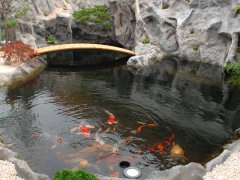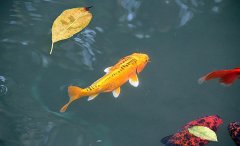What species of koi have spirituality? artificial reproduction of koi
1. Artificial natural reproduction of koi
The parent fish of the same species with high quality and good pedigree were selected and the ratio of male to female was 1: (2: 3). Put it into an independent clear pool or cage to let it lay eggs naturally.
2. Artificial dry insemination of koi
The parent fish of the same species with high quality and good pedigree were selected, and the ratio of male to female was 1: 2 in an independent clear pool or cage, and the fish nest was hung on the water surface.
When they chase each other and prepare to start spawning, remove the female fish, anaesthetize them with anesthetic, dry the water on the fish with a dry towel, gently press on the abdomen, pack the extruded eggs with a small plate, and note that there can be no water at this time.
Then, use the same method to catch the male fish, anaesthetize with anesthetic, dry the water on the fish with a dry towel, gently press on the abdomen, absorb the semen with a straw, put the semen in the eggs that have been taken, and stir evenly with chicken feathers (or duck feathers, goose feathers).
Finally, sprinkle the stirred eggs evenly on the fish nest in the water, pay attention to the spawning should not be too dense, should be uniform, this process should be rapid and accurate.
3. Brocade carp hatching
After absorbing water, the fertilized egg can use uranium bicarbonate solution (0.04%) + salt (0.04%), sprinkle wine in the whole pool to prevent the damage of water poison, and then hatch in clean water. It is best to pump air to make the water have microflow, which is beneficial to the breathing of the eggs.

4. Cultivation of brocade carp fry
The moment the brocade carp fry pops out of its eggs, a new life is born.
If the water temperature is low and the accumulated temperature is long, it will take more time to hatch; on the contrary, if the water temperature is high and the accumulated temperature is short, it will take less time to hatch.
Because nutrients are consumed during incubation, the hatching time is too long and the hatched seedlings will be very weak.
But it is not the shorter the better, the time is too short, the seedlings often have a certain number of malformed seedlings, the development is not sound, these seedlings are not easy to survive. It is ideal to hatch at 3-4 days, that is to say, the water temperature is 22-25 ℃.
Fish fry will not eat after hatching, rely on yolk nutrition to develop and maintain survival, at this time the fry are mostly attached to the pond or fish nests, water plants do not move, such as poking water, will jump, but can not swim.
At this time, it is best not to disturb it, if it is turned on the aerator, it is best to adjust the ventilation, so that fish fry reduce activity, in order to facilitate its development and growth.
When the water temperature is 22 ~ 25 ℃, the fry begins to develop in 3 ~ 4 days, and a bright spot can be seen in the middle part of the fry, which is fat, which is called "waist point" by experts.
At this time, the fry can swim sideways, which also proves that it has developed to a very good extent, and the yolk for nutrition has been absorbed, and it is time to eat.
When you see this, it is time to start feeding, which is called "opening material" in experts. If it is not fed in time, the fry will die of weakness.

What are the opening materials? There are generally two major categories.
(1) Natural opening material:
There are countless small life in the natural water body, such as rotifer, paramecium, cladocera, table pod, algae and so on. These small creatures are good natural opening materials for fish fry.
They can provide enough nutrition for the fry to grow rapidly. To raise fry in a pond, the most important thing is fertilizer and water, and the opening material for cultivating these fry.
(2) artificial opening material:
There are usually cooked egg yolk water, fish meal, harvest shrimp, and now there is artificial microcapsule feed, so as to ensure the normal feeding of fish fry in the process of cultivating fish fry, we should pay attention to the amount of feed, which should be moderate, not only to ensure that the fry can be full, but also not to affect the water quality and cause hypoxia and bad water.
With the growth of fish fry, it is necessary to increase the amount of feed and the range of feed to ensure the nutritional demand of fish fry.
- Prev

Selection of juvenile koi and daily culture of koi
The daily management of brocade carp culture is very important. As koi lives in water, water management ranks first in the daily management. The quality of water quality directly affects the normal growth of koi. With fresh water and plenty of oxygen, the fish will live a healthy life.
- Next

What kind of koi is easy to breed and what are the effects of probiotics on the water quality of koi?
What are the effects of probiotics on the water quality of koi? Koi also have very high requirements for water quality, and probiotics can help create good water quality. What are the effects of probiotics on the water quality of koi? It is mainly shown in the following three aspects: 1, the growth of some probiotics.
Related
- On the eggshell is a badge full of pride. British Poultry Egg Market and Consumer observation
- British study: 72% of Britons are willing to buy native eggs raised by insects
- Guidelines for friendly egg production revised the increase of space in chicken sheds can not be forced to change feathers and lay eggs.
- Risk of delay in customs clearance Australia suspends lobster exports to China
- Pig semen-the Vector of virus Transmission (4)
- Pig semen-the Vector of virus Transmission (3)
- Five common causes of difficult control of classical swine fever in clinic and their countermeasures
- Foot-and-mouth disease is the most effective way to prevent it!
- PED is the number one killer of piglets and has to be guarded against in autumn and winter.
- What is "yellow fat pig"? Have you ever heard the pig collector talk about "yellow fat pig"?

